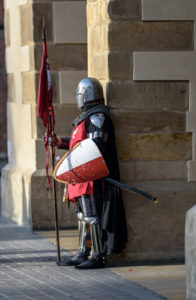The Original and #1 Website for Security Guard Training |
Online Security Guard Training and Career Center
Welcome to Security Guard Training Headquarters! We have everything you need to make your life easier as you begin your career as a security guard officer. State specific training requirements, a step-by-step hiring process, potential employers and interviews to help you get hired are just some of the helpful things you'll find here.

Essential Security Guard Gear
 Depending upon the type of post where you are assigned, your gear that your employer supplies for your position and other highly recommended gear will differ. The most important advice for any new security officer is to ensure that any gear that you bring to your job has the blessing of your employer.
Depending upon the type of post where you are assigned, your gear that your employer supplies for your position and other highly recommended gear will differ. The most important advice for any new security officer is to ensure that any gear that you bring to your job has the blessing of your employer.
One simple example is a psychiatric hospital. As the chief of security at a psychiatric facility, it would have not been considered appropriate by my employer that I carried pepper spray. The facility would have frowned upon the idea that officers would possibly spray a patient, even in a dangerous situation. Any gear that you bring, it is best to get prior approval. Many employers of security guards rightfully fear someone letting their gear go to their head and doing something over the top that could get the employer sued.
Employer-Issued Gear
Depending upon the type of site where you are working, you may be issued the following types of gear:
- Your uniform
- Two-way radios
- Facility keys
- Your badge and/or ID card
- A firearm and holster
- A duty belt that can hold your equipment
- A watch clock or cell phone
- A clipboard with logs to delineate the events of your shift
The watch clock is an older means of demonstrating to your employer that you are covering your rounds at the required times. There are keys that are found at different places in the facility. As you go about your rounds, you turn the key in the watch clock at each station, showing you have completed your full rounds. The printout from the watch clock will show at what time you visited each station on your rounds.
The practice of using watch clocks is giving way to the use of facility-issued cell phones and QR codes at different stations. As you go about your rounds, you hold the phone up to the QR code at the station. Often, such phones will show your employer where you are located in the facility at any given moment.
The nice thing about employer-issued cell phones is that you can quickly record a video or photo of any problem or disturbance for your employer, and it can be instantly transmitted to them in an emergency or an urgent situation. If you are not issued a cell phone, it would be best to carry your personal phone on you for these very purposes
Possible Employee-Discretion Items
Again, depending upon your post and your employer, you may need to add more to your gear in order to have a comfortable and safe shift. The following are some helpful and key items of gear that your employer will likely not provide.
Boots
As described by Security Guard Training Central, most firms require you to wear black boots or shoes. You need to have them neat and clean. Look for comfort, so you won’t be in pain if you are on your feet for a long time. If you are security for a logging operation out in the field, or for a construction site, you may be required to have black boots or shoes have steel toes. Such shoes are actually easier to find than you think because many employers require steel-toed shoes.
Hat
If you are not from a cold climate, you may not be aware that the largest loss of heat in your body is through your head. You will stay warmer in the evening, or even in the day, when you either have an outdoor post or outdoor rounds in a chilly location and you wear a warm hat. The Department of Homeland Security suggests a fake-fur trooper hat.
Jacket
A bomber-style, security guard jacket is one of your best investments, if you are posted outdoors or do outdoor rounds when it is chilly. Often, your employer will not have any issues with such a jacket, as long as you keep it neat and clean.
Warm Gloves
If you are in a chillier environment, you will need some warm gloves. Depending upon the temperature, you might need woolen gloves for warmth above 40 degrees or leather, insulated gloves in temperatures closer to freezing. Black is your best bet because it will go with your uniform.
Long Underwear
These days, you can get quality, performance long underwear that is warmer than the typical cotton long underwear found in the stores. A really good source of quality long underwear is Cabela’s. They sell military-spec long underwear.
Flashlight
Most any employer won’t mind if you have at least a small Maglight, and possibly even a large one, on your duty belt. It is safer to opt for a small one, unless you ask your employer in advance. You will need a belt holder for the light as well.
A big tip is that the new LED lights tend to go much easier on batteries than the Maglights and have the power today that Maglights do. Also, the LED light bulbs last almost forever, but Maglight bulbs go out at times when it might be a problem for you.
Latex Gloves
The San Francisco Chronicle suggests that, if you might be called upon to touch someone, such as a patient or a suspect, it is good to carry a holder and a few pairs of latex gloves. This will keep you and the person you are touching safe from bodily fluids.
Handcuffs
If your employer has not issued these, do not come to work with handcuffs and a holder for your duty belt unless you have prior approval. Many places do not want security guards to have these, unless they have been issued to them.
Baton
Like the handcuffs, if your employer did not issue it to you, you will likely not be approved for wearing a baton on your duty belt. Some states have restrictions against security guards carrying batons.
Other gear suggested by the Department of Homeland Security includes:
- A key keeper for your duty belt
- An ammo case, if you are armed, and body armor
- Rain slicker

Leave a Reply